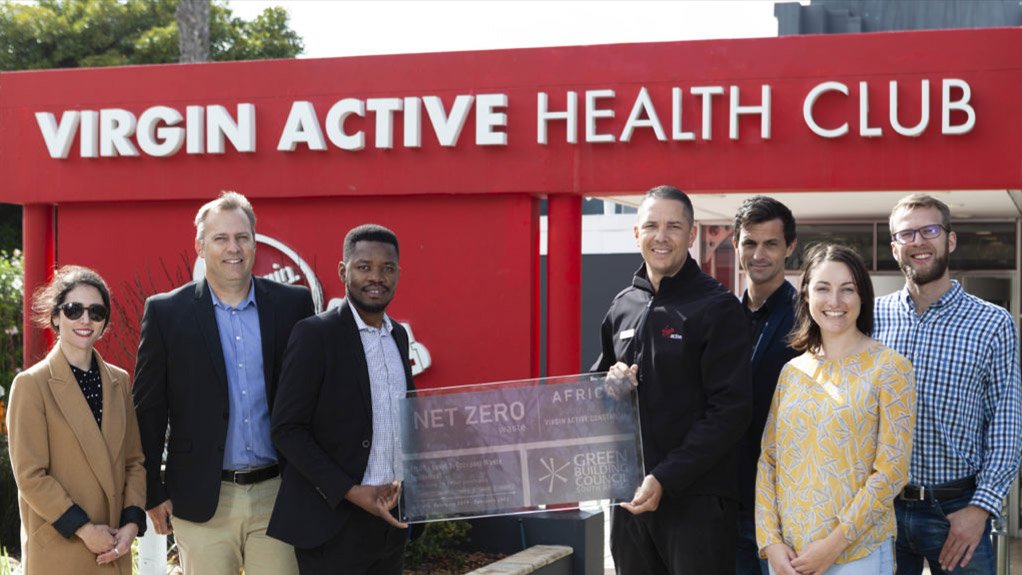Through rigorous waste reduction, separation and recycling on site, and the assistance of net zero-accredited professionals Ecolution Consulting, Health Club Virgin Active Constantia, in Cape Town, achieved a Net Zero Waste certification from the Green Building Council of South Africa.
“Currently, 93% of the gym’s waste is being diverted – an amount that was possible through an initial waste audit calculation,” explains Ecolution Consulting founder and sustainability engineer André Harms.
To achieve a 93% diversion rate, waste reduction was the highest priority for Virgin Active, he says. “Food waste, overpackaging as well as the use of nonrecyclables were reduced in the cafe.”
The facility’s waste streams have been separated into recyclables, organic waste and general waste – all on-site recovery – to ensure as little waste as possible ends up in the general waste bin destined for landfill, says Harms.
Further, to calculate the carbon equivalent of the 7% currently not being diverted, the UK’s Department of the Environment, Fisheries and Rural Affairs factors were used to “ascertain how many carbon offsets needed to be purchased to neutralise the remaining negative impact”.
The carbon offset was purchased through environmental sustainability solutions company impactChoice from a offset facilitation company.
A carbon offset is a reduction in emissions of carbon dioxide or other greenhouse gases made to compensate for emissions elsewhere. Therefore, Virgin Active ‘sold off’ its remaining carbon emissions by funding the forest conservation project, Kariba Reducing Emissions from Deforestation and Forest Degradation project. This project aims to provide sustainable livelihood opportunities for poor communities in northern Zimbabwe.
He adds that impactChoice has bought the carbon offset for the next 12 months, with commitments to purchase further. “The gym also has plans to support further diversion from landfill through providing bins for members to bring their recyclables from home to be recycled through the Virgin Active scheme.”
Offsetting must be seen as a temporary solution for taking ownership for the last remaining impact one cannot currently practically resolve through best practice operations or on-site technologies, says Harms.
Meanwhile, Ecolution assisted Growthpoint Properties in certifying The District in Woodstock as the second commercial property in Cape Town to be awarded with a Net Zero Water certification, which means that it no longer relies on the municipal water grid.
A Net Zero Water building is one which is designed, constructed and operated to reduce its water consumption and then offset its remaining water demand with harvested, recycled and reused water. This means that the volume of water consumed is the same as that produced, or even Net Positive, where the water recycled is greater than that consumed.
The property has a water filtration plant installed that can generate 140 000 ℓ/d from four sumps in the basement supplying 100% of the building’s water needs. The seven-storey building is built on top of a naturally occurring spring that flows into the basement and is collected by the sumps and plant.
To prevent flooding, spring water has traditionally been pumped into the city’s stormwater system. Instead, the building uses the sump water for drinking water and toilet flushing, besides others.
Meanwhile, there is a perception that it is going to cost more money to construct a Net Zero building because there is greater capital outlay in the beginning, which can range from about 2% to 11%, explains Harms. This is often not the case as green building budgets are “typically on the lower end of that range and, when applied professionally, it is paid off in a short time, since the benefits far outweigh the costs”.
He adds that companies should first consider passive design elements and changes that are easy and cost effective: “Passive design is not as flashy or obvious as something like solar panels, but it can go a long way towards improving the sustainability credentials of a building at a minimal cost”.
Making buildings green is part of building resilience and future proofing against climate change to mitigate any potential risks, as well as hedging against rising utility costs, explains Harms. He adds that there are also operational cost savings because of a decrease in water and electricity use.
Harms concludes that many companies will go green in the future, because of industry, consumer and regulatory pressure to do so.
Edited by: Zandile Mavuso
Creamer Media Senior Deputy Editor: Features
EMAIL THIS ARTICLE SAVE THIS ARTICLE
ARTICLE ENQUIRY
To subscribe email subscriptions@creamermedia.co.za or click here
To advertise email advertising@creamermedia.co.za or click here













